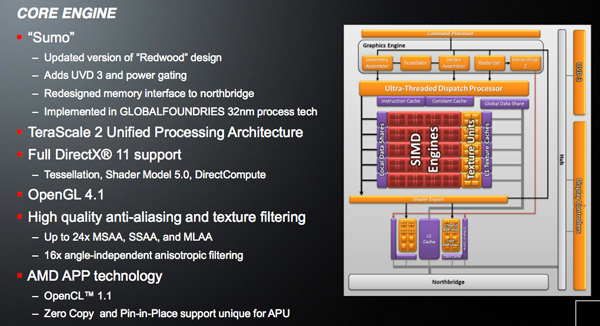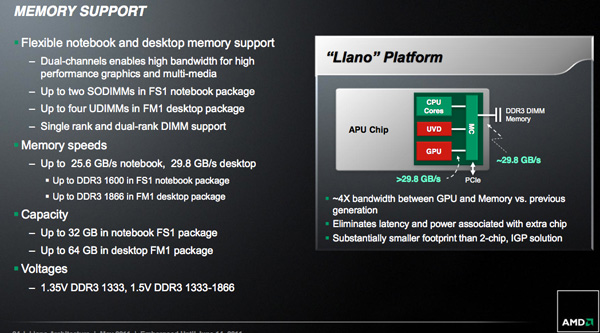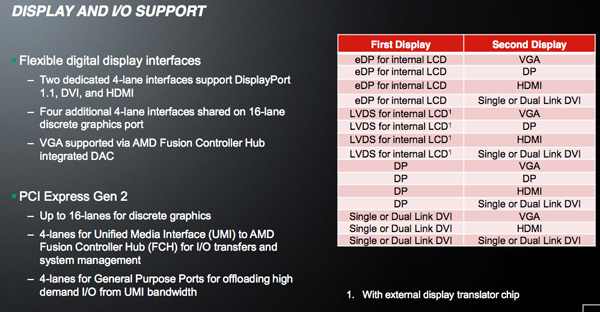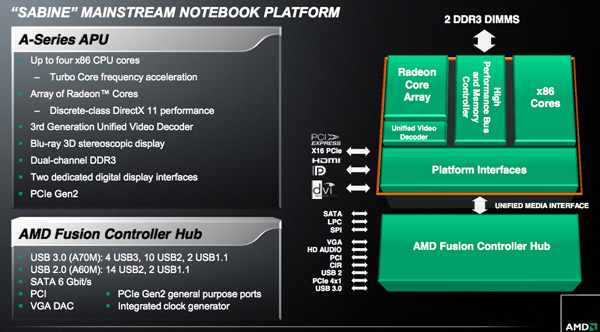The AMD Llano Notebook Review: Competing in the Mobile Market
by Jarred Walton & Anand Lal Shimpi on June 14, 2011 12:01 AM ESTThe GPU
While the Llano CPU cores may be in need of a major overhaul, Llano's GPU is as new as it gets. Technically based off of AMD's Redwood core (Radeon HD 5570) with some enhancements, Llano's GPU is codenamed Sumo.
The DX11 GPU features five SIMD arrays, each with 80 cores for a total of 400 shader processors. Similar to the updates we saw with this year's Northern Islands GPUs, Sumo does add UVD3 support to the Redwood architecture. Of course since Sumo shares the same die as the Llano CPU cores it is built on GlobalFoundries' 32nm process, making this the first AMD GPU fabbed at GlobalFoundries and not TSMC.
For everything behind the memory controller Sumo is virtually identical to Redwood. Where Sumo differs is in its memory interface. Although Llano is AMD's first performance oriented APU, it's still constrained by a 128-bit wide DDR3 memory interface. That dual-channel memory interface has to be shared by all four Llano cores as well as the Sumo GPU and as a result, arbitration is very important.
AMD shared a few choice details about the Llano memory controller architecture. To begin, AMD guarantees more than 30GB/s of bandwidth is available between the GPU and the memory controller—in other words, the path from GPU to the memory controller won't become a bottleneck. The GPU/memory controller link (i.e. within the APU die) can apparently scale up to as much as 50GB/s to support future APUs with even faster memory interfaces. Note that unlike previous integrated graphics solutions, there is no support for dedicated external memory—this is a pure shared memory architecture.
Second, and most importantly, AMD can dynamically prioritize memory bandwidth between the CPU and GPU. In most cases, when both processors are heavily consuming data, the GPU is given priority over the CPU. Given today's workloads, prioritizing the GPU for memory accesses makes sense when it's running full tilt. The chances of you stressing all four CPU cores and running at full GPU memory bandwidth requirements are pretty slim today.
With 400 shader processors behind a shared 128-bit DDR3 memory interface, the upper bound for Sumo performance is the Radeon HD 5570. In practice, you should expect performance to be noticeably lower since the GPU does have to share its precious memory bandwidth with up to four x86 CPU cores.
The mobile version of Llano supports up to DDR3-1600 while the desktop parts can run at up to DDR3-1866. Maximum memory capacities are 32GB and 64GB for notebooks and desktops, respectively.
Llano has a total of 24 PCIe Gen 2 lanes at its disposal. Sixteen of those lanes can be used for external graphics. Four of the lanes can be used for devices that need low latency/high bandwidth access to the APU itself (e.g. Gigabit ethernet). The remaining four lanes are used to connect the APU to its sole partner in crime: the Fusion Controller Hub.
AMD is particularly proud of the display output configurations supported by Llano. The possible combinations are listed below:
Chipsets
AMD will offer two Fusion Controller Hubs (FCHs) as options for Llano: A70M and A60M. The only difference between the two is in their support for USB 3.0; the A70M has four USB 3.0 ports while the A60M has none.
Both FCHs support 6Gbps SATA and perform just as well as AMD's 8-series chipset (or Intel's Z68) with a high performance SSD. USB 3.0 performance is also comparable to 3rd party solutions we've seen deployed on motherboards already.















177 Comments
View All Comments
duploxxx - Sunday, June 19, 2011 - link
talking about crap??? men you are good at that, as if you need a 2600K for some compiling and add a 6990 to an e-350.men you do know someting about computers :) your a joke
BushLin - Wednesday, June 22, 2011 - link
If you're going to accuse someone of talking crap (correctly or otherwise) it helps if you know the difference between you're and your when attempting to insult them.Broheim - Monday, June 27, 2011 - link
I use a fast CPU for compiling because I actually like being productive rather than just staring at the screen.my point about the 6990 was that a faster GPU != a better user experience for the vast majority of users, but logic seems to be lost on you.
Regenweald - Tuesday, June 14, 2011 - link
I'm currently playing the Witcher extended with a 2Ghz X2 ,a 4670 and 800 Mhz memory on a desktop with no complaints. In game settings medium and high. Are you saying that 2 more tweaked 32nm cores, 80 more shaders and ddr3 1600 or 1800 memory will not offer a good mobile gaming experience ? please.jollyjugg - Wednesday, June 15, 2011 - link
What kind of super computing application are you going to do in your laptop that you would need that "tremendous CPU power" that you are talking about. As somebody who has used both intel and amd machines for years I can tell you that for most user applications, you will hardly notice any difference in performance. The main complaint was that AMD machines were running hot particularly after intel cameup with power gating in nehalem in 2008. With this part you get a machine that runs way way cooler and almost 150- 200 bucks cheaper than comparable intel machines plus you get discrete quality graphics for free. Nobody can change cynics like you. Because you cant expect Intel to sell anything cheap you would want to AMD to sell things cheaper. Well if you want good things in life you should be prepared to pay. Dont write trash. Like gaming is not important for average user, tremendous computing power and 3 GHz CPU speed is also not important for the average PC user. But multimedia and movie rendering etc is. So go Llano!!!Seikent - Tuesday, June 14, 2011 - link
This platform offer some good things, but if the prices aren't low it won't go well. Now it's quite easy to find a sandy bridge notebook with discrete gpu for a few more dollars.If ACF does achieve to work like CF in the future, it would be great!
SteelCity1981 - Tuesday, June 14, 2011 - link
Finally we have an intergrated graphics solution that's worth really talking about.aegisofrime - Tuesday, June 14, 2011 - link
Judging by the performance, this part won't be priced very high. And that's a worry, considering that it packs 1.45 billion transistors. In comparison, Sandy Bridge is 995 million transistors, and sells for more money. Profit margins are gonna be tight on this one.JarredWalton - Tuesday, June 14, 2011 - link
AMD has a slide that points out that compared to their previous generation, they're packing a 66 mm2 Northbridge, 200 mm2 CPU, and 1080 mm2 dGPU into a 228 mm2 package. They've made money this past quarter, so this should do better than Athlon/Phenom II.JarredWalton - Tuesday, June 14, 2011 - link
Note: that's supposed to be 108 mm2 GPU, not 1080. Whoops.